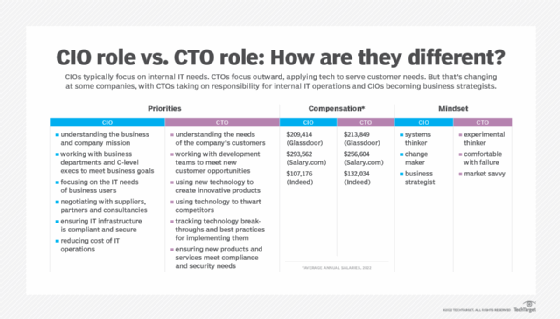CIO vs. CTO: Key differences in roles and responsibilities
CIOs and CTOs both play a valuable role in a company's technology strategy, but their focus and responsibilities are different. Learn more.
CIOs and CTOs both play a valuable role in improving enterprise IT systems and creating new products at the executive level. Indeed, in some respects, the terms are relative and depend on the individual company, business goals and the personalities involved. In general, however, the CIO and CTO are distinct roles with different responsibilities.
The key difference is that CIOs tend to have a more inward focus and look for ways to trim the costs of IT infrastructure while ensuring compliance and boosting productivity. CTOs tend to have a more outward focus and are looking for ways that new technologies could grow opportunities.
"In a perfect world, the CTO and CIO bring out the best in one another and complement each other," said Rajeev Sharma, CTO of Grid Dynamics, a digital transformation consultancy. "They both aim to bring value, but there is also this critical tension between the two."
A CIO's focus on cost can hamper the ability to generate value by modernizing technology at scale. The CTO's focus on opportunities to grow sales and revenue and provide the best customer experiences can incur new costs with no immediate payback.
This article is part of
The evolving CIO role: From IT operator to business strategist
Every company will approach the balance between these two roles differently, and some may even combine them. Here we delve into some of the subtleties of how different companies approach the roles, why companies often need both positions and how these two IT leaders can work together to create greater value.
What does a CIO do? Common roles and responsibilities
In keeping with the CIO mandate to align IT services with the company's business strategy and goals, the CIO job commonly includes the following priorities and duties:
- understanding the business and company mission;
- focusing on the IT needs of business users;
- working with other business departments and C-level execs to meet business goals;
- negotiating with suppliers, partners and consultancies;
- ensuring IT infrastructure is compliant and secure; and
- reducing the cost of IT operations.
What does a CTO do? Common roles and responsibilities
In line with the CTO focus on using technology to drive top-line growth, the CTO job commonly includes the following priorities and duties:
- understanding the needs of the company's customers;
- using new technology to create innovative products;
- working with development teams to meet new customer opportunities;
- tracking technology breakthroughs and best practices for implementing them; and
- ensuring that new products and services meet compliance and security needs.

Key differences between CIO and CTO roles
Sharma said that CIOs are typically more business-focused than CTOs and act as the financial watchdogs of the IT organization. They figure out how to do more with less and are challenged to work within the business constraints of the company. They are typically concerned with IT budgets, productivity, business roadmaps and IT objectives. While some companies choose CIOs from the business ranks, this trend has faded in recent years.
 Rajeev Sharma
Rajeev Sharma
"Today, CIOs are expected to be very technology savvy given the heavy focus on digital transformation," he said.
Sharma sees the CTO job as also very tech-focused -- but in a different way from the CIO's. Because of their mandate to use tech to improve customer services and products, CTOs think about how to solve customers' problems and about assembling the resources needed to do that. Savvy about business, they think about building core technology platforms that provide a competitive advantage. They also focus on increasing the barriers to entry for competitors by creating a disruptive technology ecosystem that is hard to mimic.
Any discussion of the CIO vs. CTO role must also consider how these roles have changed in recent years as the economy and nature of business have changed, said Donncha Carroll, partner in the revenue growth practice of Axiom Consulting Partners.
 Donncha Carroll
Donncha Carroll
"Over the years, the CIO role has been elevated from an IT infrastructure-based role to something much more strategic and more complex," said Carroll, who leads Axiom's data science center of excellence. "Meanwhile, the scope of technology-based initiatives has grown so significantly in the last 10 years that it has necessitated the creation of two roles at many companies."
Both The CIO and CTO roles are thus technology-driven, but successful incumbents tend to have different backgrounds and skill sets and, as suggested above, apply their capabilities to different problems or opportunities.
- Systems vs. experiences. For example, while both roles require making essential contributions to strategy development and execution, the CIO is more of a systems thinker, looking across the enterprise for technology opportunities that will impact broader business processes. The CTO is more focused on using technology to innovate, evolve and enhance customer experience.
- Business models vs. markets. The CIO tends to work with business leaders to optimize the company's operating model, while the CTO is more focused on the company's relationship with markets and customers. As a result, the common boundary that is drawn is that CIOs are focused on internal constraints and CTOs on external constraints. "Of course, it's not that simple because the two roles are inherently connected and challenging to pull apart," Carroll said.
It is also essential to keep in mind that every company will approach these roles differently.
 Dan Priest
Dan Priest
"There is no one standard for the roles of CIO and CTO," said Dan Priest, managing partner at PwC. "While there are common themes related to technology management, there are important differences [required of the roles] across companies and industries."
In some cases, those differences are driven by the personalities who have the job, and in other cases, it is a function of the industry sector, Priest explained.
At software and technology businesses, for instance, the CTO is typically responsible for revenue-generating products. CIOs at these businesses are typically responsible for the information technology used to support running the business. Priest said this vendor model of the two roles is also gaining traction in product-based companies, as technology offerings become an integral component of their revenue models. In these companies, the CTO typically has a direct reporting relationship to the CEO or profit and loss leader.
However, in other industries, where CIOs are responsible for the end-to-end management of all information technology, Priest said CTOs often report to the CIO office and take on the responsibility of IT engineering, infrastructure and operations. Who has primary accountability for what is often a matter of debate at companies.
"The responsibilities that are often debated include data, analytics, and digital, all of which could be outside the CIO organization entirely," Priest said.
On the couch: CIO mindset vs. CTO mindset
There's also no shortage of debate about the personalities and priorities of CIOs vs. CTOs. According to Sharma, CIOs are rationalists and problem solvers. "I often think of them as company auditors and [people who] challenge folks to do things better or differently."
The CIO's North Star, according to Sharma, is usually the dollars spent for a given output, or doing more with less.
In contrast, he said CTOs are less concerned about cost than about increasing technology capability, for example, building expensive compute and storage infrastructure for running complex AI/ML algorithms for business impact or developing cloud-native applications for solving complex business problems. While CTOs are necessarily focused externally on the competition, in order to do that, Sharma said they must also focus on internal practices such as maintaining an R&D program, nurturing and coaching an internal talent pool, working with HR and with sales and marketing.
Carroll also sees a difference in how the two IT executives make their mark in the enterprise. He sees CIOs as internal team builders and promoters of working environments that emphasize speed, efficiency and quality. However, the changes made by CIOs are often gradual because they are broad-reaching and can involve not only building new technology capabilities but making and managing fundamental changes to the ways people work, which takes time.
The CTO's focus on innovations that directly and indirectly improve customer experience means they work most closely with a select group of frontline people, including salespeople, customer service teams and product managers. Carroll said CTOs tend to be more open to experimentation than CIOs and perhaps more tactical. As product builders, they necessarily must take an iterative approach and tend to be comfortable with failure. They use tactics like rapid prototyping and A/B testing to understand the relationship between action and response.
CIO and CTO responsibilities evolving, even reversing, at some companies
PwC's Priest, on the other hand, is starting to see a role reversal at some companies, with CIOs looking outward and CTOs focused internally. He said it now is common for CIOs to hold prominent positions in the C-suite, actively engaging in business strategy and collaborating with leaders across the business on topics related to tech and beyond. Increasingly, tech is not just an enabler of business strategy once the strategy has been set; it has now become an intrinsic part of business strategy development.
"So, CIOs have to approach their jobs as business and technology strategists, not just operational leaders," Priest said.
In enterprises where the CIO is deeply engaged in business strategy, Priest said he's seeing the CTO role focused on internal operations. Although these CTOs still think strategically about technology, they also have the weighty responsibility of making the technology work in production without disrupting business. These types of CTOs tend to focus on IT standards and enterprise architecture and possess deep engineering skills.
CIO vs. CTO: Average salary comparison
Average annual compensation for these two roles varies depending on the source. In 2022, Glassdoor indicated that total compensation for CIOs and CTOs were comparable -- with CTOs earning an average of $4,000 more than CIOs. However, Salary.com found average compensation was almost $37,000 more for CIOs. In contrast, Indeed indicated CTOs earned about $22,000 more for base compensation.
Here are the average salaries for CIO, as of May 2022. (Numbers fluctuate.)
- (Glassdoor) $209,414
- (Salary.com) $293,562
- (Indeed) $107,176
Here are the average annual salaries for CTOs in 2022.
- (Glassdoor) $213,849
- (Salary.com) $256,604
- (Indeed) $132,034
Do businesses need both a CIO and a CTO?
The consensus of experts is that every business will need to craft its own approach to these roles.
In larger enterprises, it is a good practice to have both roles.
Smaller and mid-sized companies may find that a single technologist can fulfill both roles, or they might decide to simply outsource their technology needs to cloud providers, so they can focus on their key business differentiators.
New cloud SaaS applications are certainly lowering the demand for internal IT management for many types of businesses. Some companies may substitute other roles for related tasks. For example, a chief product officer may replace the function of a CTO for some industries. In other businesses, the role of a CIO may be replaced by newer ones, such as a chief digital officer.
 Neil Kole
Neil Kole
"With the widespread adoption of the cloud spreading from applications to infrastructure, the line between CIO and CTO has started to blur," said Neil Kole, CIO at Boomi, the intelligent connectivity and automation leader.
"With the proliferation of cloud infrastructures, many traditional IT deliverables have been commoditized. This does not mean IT has become less relevant. IT must evolve its focus to more effectively enable the business to operate in a secure, accountable and frictionless environment," Kole said.
How do CIOs and CTOs work together and collaborate?
According to Caroll, there is a built-in tension between CIOs and CTOs because they "have several shared responsibilities," he said.
For example, CIO-driven initiatives that change internal technology systems and processes will often indirectly impact customer experience or service quality. An example is configuration changes in a CRM system. CTOs might promote a technology that changes the service model for different customer segments, adding complexity to IT service delivery, or they might add new capability requirements such as DevOps, or rewire connections between systems.
It is important that CIOs and CTOs work things out when their approaches conflict.
"The technology team can address conflict by clarifying decision rights and governance, but success will depend on creating forums that promote a close collaboration between the roles," Carroll said. These interactions should be designed around the critical points of intersection (e.g., shared systems or resources) and encourage openness, transparency and problem-solving that gives both roles visibility into planned changes and connects every action and decision to strategic enterprise objectives.
In some cases, the CIO can play a role in shaping the CTO role. Priest said PwC worked with a large U.S.-based health insurance company that underwent a significant transformation of its IT organization. The CIO took a prominent role in the C-suite, helping shape not only the data and technology strategies but also the business strategy. The CIO hired a CTO who took responsibility for transforming the company's enterprise architecture and infrastructure operations, which were essential "capability investments" to bring to life the business strategy.
"The new organization earned recognition by business stakeholders for improving day-to-day operational performance, but also for producing more strategic capabilities faster, such as new mobility products," Priest said.
How to become a CIO: Common qualifications and experience
Good CIOs should master a variety of technical and business skills, including the following:
- IT systems infrastructure;
- negotiations and communication skills;
- budgeting and accounting;
- business management; and
- overview of governance, risk management and requirements.
How to become a CTO: Common qualifications and experience
Good CTOs should master a variety of technical and business skills, including the following:
- modern technology infrastructure;
- familiarity with AI, machine learning, data management, networking and cloud;
- product development;
- DevOps and iterative software development; and
- implementing a center of excellence.







